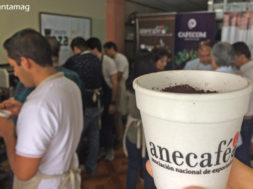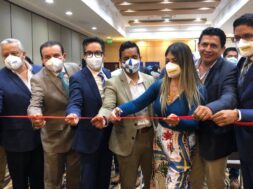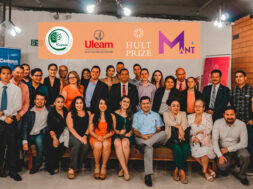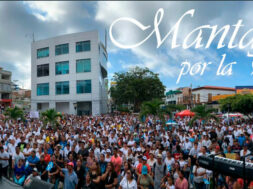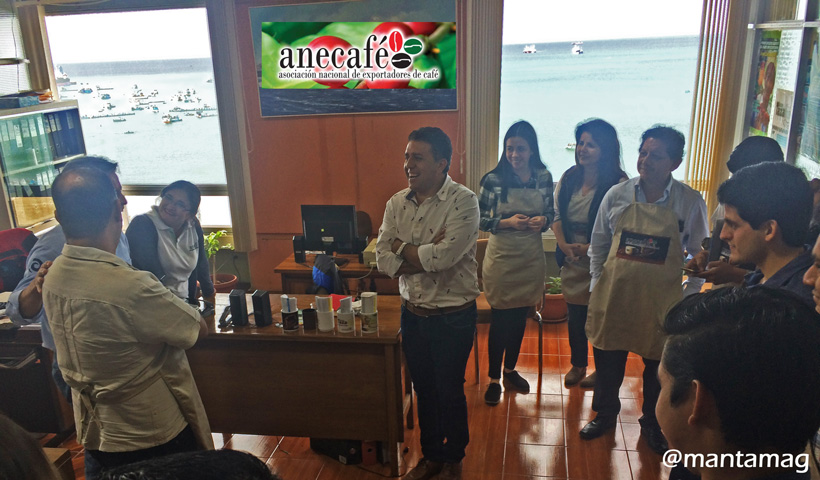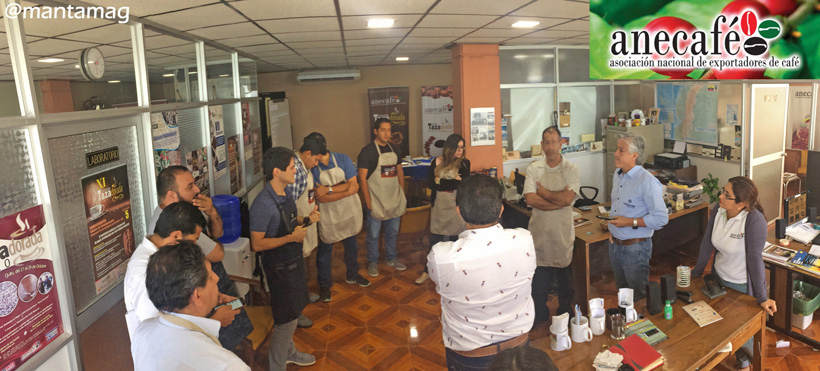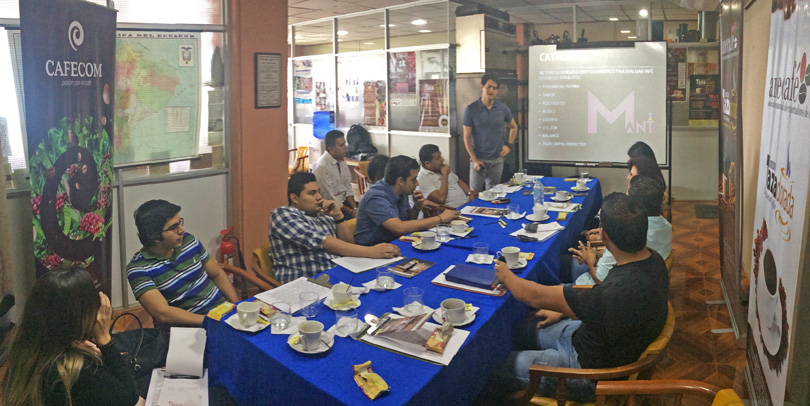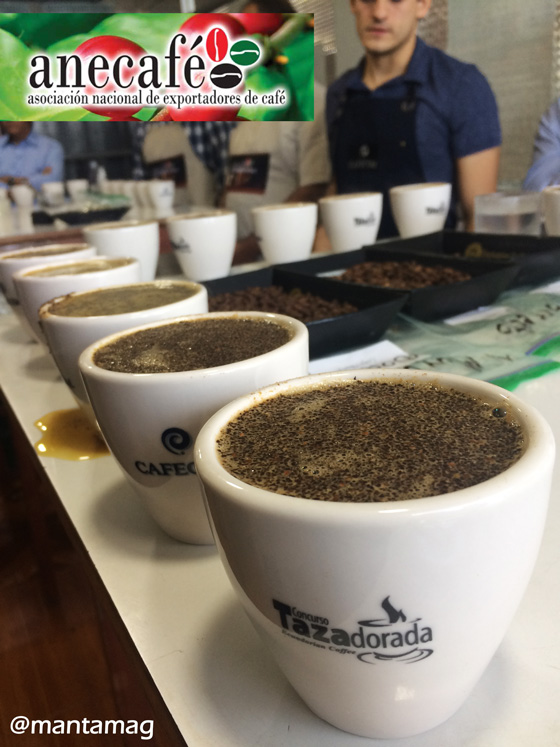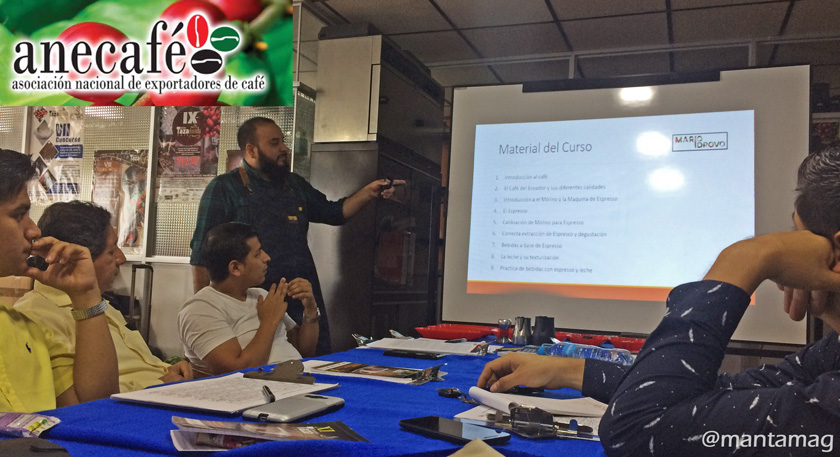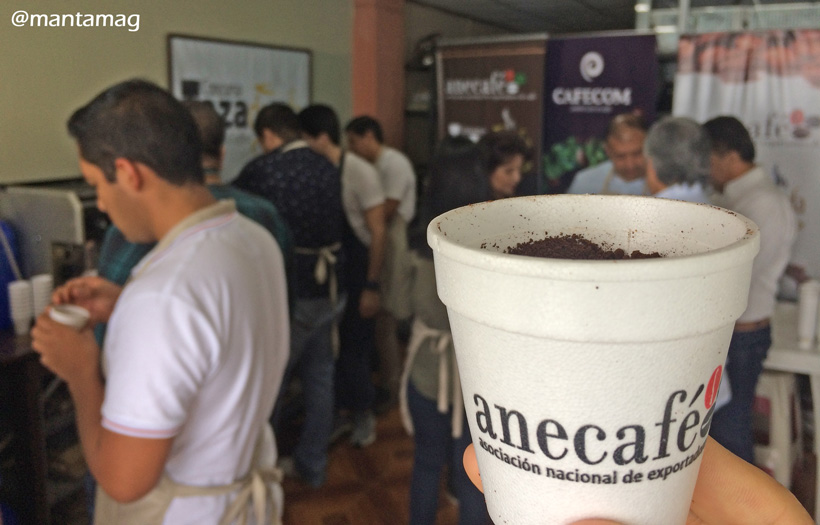
ANECAFÉ, culmina exitoso curso de CATACIÓN Y BARISMO en Manta
presentado por / presented by: @anecafe_ecuador
(HISTORIA INSTAGRAM, VIDEO DESTACADO, click aquí! / highlight instagram story video, click here)
La Asociación Nacional de Exportadores de Café (ANECAFE) y su escuela de formación y capacitación en CATACIÓN Y BARISMO, realizaron un curso teórico y práctico dirigido a amantes de la exótica fruta y sus semillas (productores, tostadores, empresarios, entre otros). En total, fueron 12 los cupos asignados para este encuentro de dos días de duración (17 y 18 de julio, 2018).
// The National Association of Coffee Exporters (ANECAFE) and its training school in Tasting & Barista, held a theorical and practical course aimed to lovers of the exotic fruit and its seeds (producers, roasters, entrepreneurs, among others). In total, there were 12 spots assigned to this two-day meeting (July 17 and 18, 2018).
El evento contó con el auspicio de CAFECOM y el lugar designado fue la oficina de Anecafé en la ciudad de Manta, ubicado en el Banco del Pichincha 10mo piso.
// The event was sponsored by CAFECOM and the designated place was the Anecafé office in Manta city, located at Banco del Pichincha building, 10th floor.
Podría interesarte también: Anecafé pone a funcionar este mes un laboratorio
El primer día arrancó con una entusiasta bienvenida por parte de la organización. Pablo Pinargote, Gerente de ANECAFE resaltó la importancia del sector y como este tipo de capacitaciones contribuyen a masificar el consumo interno nacional.
// The first day started with an enthusiastic welcome from the organization. Pablo Pinargote, ANECAFE General Manager highlighted the importance of the industry and how this type of training contributes to mass domestic consumption.
Así mismo, Vinicio Dávila, Vicepresidente de ANECAFÉ, con 35 años de experiencia en el sector cafetero y también organizador del prestigioso concurso nacional (que promueve las buenas calidades) “TAZA DORADA“ destacó el aporte cultural que realiza la institución y la ventaja competitiva que posee Ecuador a nivel internacional.
// Likewise, Vinicio Dávila, Vice-President of ANECAFÉ, with 35 years of experience in the coffee industry and also, organizer of the prestigious national contest (which promotes good qualities) “TAZA DORADA” highlighted the cultural contribution made by the institution and the competitive advantage Ecuador has on international markets.
Ambos hicieron referencia a la presencia de nuevas generaciones en la catación y el barismo ecuatoriano, mencionando que hace 15 años en hoteles de 4-5 estrellas en el Ecuador aún se tomaba café soluble.
// Both made reference to the presence of new generations in the ecuadorian coffee tasting & barista areas, mentioning that 15 years ago in 4-5 star hotels in Ecuador, people still drank soluble coffee.
CATACIÓN / coffee tasting
La instrucción estuvo a cargo de dos reconocidos instructores certificados a nivel internacional, el maestro barista Ing. Mario Idrovo (Campeón nacional con una maestría realizada en Europa) y el Ing. Jonathan Davila (representante de la compañia Cafecom) quien impartió el curso de Catación.
// The instruction was in charge of two internationally certified instructors, master barista Ing. Mario Idrovo (proved national champion with a master’s degree in Europe) and Ing. Jonathan Davila (sponsor company Cafecom´s representative) who taught the tasting course.
“El protagonista es el productor” / “The coffee producer is the main character”
El inicio de la capacitación incluyó conceptos básicos acerca de los orígenes del café, sus variedades, tipos de tuestes, importancia de la cadena productiva desde la siembra hasta la taza, trazabilidad con productores, entre lo más destacado.
// The beginning of training included basic concepts about coffee origins, its varieties, roasting type, importance of the productive chain from sowing to the cup, traceability with producers, among other highlights.
También se hizo mención de las regiones con mayor producción nacional (Loja, Manabí, Zamora, Imbabura, Galápagos, Sucumbíos, El Oro) y de otras que están empezando (Pichincha, Guayas, Azuay, Chimborazo, Cotopaxi, entre otros).
//It was also mentioned the regions with the highest national productivity (Loja, Manabí, Zamora, Imbabura, Galápagos, Sucumbíos, El Oro) and others that are just starting to do so (Pichincha, Guayas, Azuay, Chimborazo, Cotopaxi, among others).
Podría interesarte: Catación de café: 5 pasos clave para el dominio de la catación
BARISMO / barista class
En el 2do día, Mario Idrovo compartió una brillante presentación que abarcó (entre otros) una introducción a el molino y la máquina de Espresso. (Se podría decir que el molino es igual o más importante que la máquina).
On day two, barista master Mario Idrovo shared a brilliant presentation that included (among others) an introduction to the mill and the Espresso machine. (You could say that the mill is the same or more important than the machine).
En la parte práctica, el curso complementó el trabajo con la presentación de la bebida como es el arte del latte, la cual se refiere a los diseños creados en la superficie del espresso.
// In the practical part, the course complemented the work with the presentation of the drink as “the art of latte”.
Felicitaciones a los asistentes por completar el curso, el primer paso de una maravillosa aventura!
// Congratulations to the attendees for completing the course, the first step of a wonderful adventure!
DATOS CURIOSOS / curious facts:
- El café es la segunda bebida más consumida después del agua. / Coffee is the second most consumed beverage after water.
- Se consumen 600 billones de tazas de café al año. / 600 billion coffee cups are consumed per year.
- Es el 2do commodity después del petróleo. / It is the 2nd commodity after oil.
- El café tiene miles de compuestos químicos que le dan muchas de sus propiedades organolépticas. / Coffee has thousands of chemical compounds that give it many of its organoleptic properties.
- La calidad y propiedades del café tiene mucho que ver con la forma como fue procesado (correcta recolección, días de secado, fermentación, etc). / The quality and properties of the coffee has a lot to do with the way it was processed (correct harvest, days of drying, fermentation, etc).
- Hace 35 años el 70% de la producción nacional estaba destinada a Italia. / Thirty-five years ago, 70% of national production was destined for Italy.
- En 1997 se producían 2 millones de sacos (qq), mientras que al 2014, la producción fue de 200.000. / In 1997, 2 million bags (qq) were produced, while in 2014, production was 200,000.
PÁGINAS RELACIONADAS:
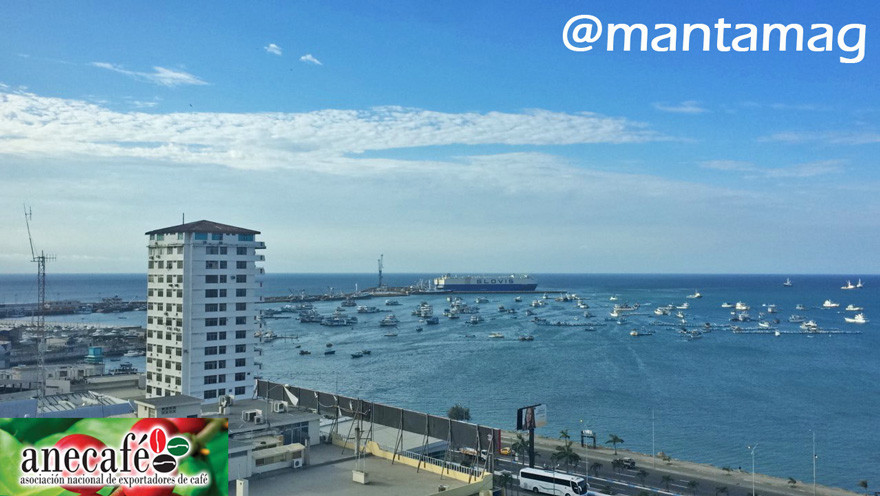
VIDEO RELACIONADO:
Situación del sector cafetalero exportador en Ecuador
(414)
